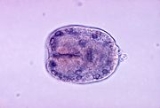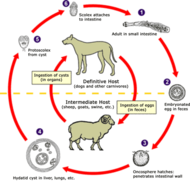
Echinococcus granulosus
Encyclopedia
Echinococcus granulosus, also called the Hydatid worm or Hyper Tape-worm, is a cyclophyllid cestode that parasitizes the small intestine
of canids as an adult, but which has important intermediate host
s such as livestock
and humans, where it causes hydatid disease. The adult tapeworm ranges in length from 2 mm to 7 mm and has three proglottids ("segments") when intact - an immature proglottid, mature proglottid and a gravid proglottid. Like all cyclophyllideans, E. granulosus has four suckers on its scolex ("head"), and E. granulosus also has a rostellum with hooks.
In canids, E. granulosus causes a typical tapeworm infection, and produces eggs that are passed with the dog's feces
. Intermediate hosts include herbivores such as sheep, deer
, moose
, kangaroo
s, and wallabies
, and any other organism (including humans) that ingests dog feces. In the intermediate host, eggs hatch into oncosphere larvae that travel through the blood
and form hydatid cysts in the host's tissue
s. These cysts can grow to be the size of a softball
or basketball
, and may contain several smaller "balloons" inside the main cyst. In the related worm Echinococcus multilocularis
, the outer cyst is not present. If the outer cyst ruptures, new cysts can form at a different location in the body. Each smaller section contains several juvenile worms, and dogs may eat millions of them, resulting in very heavy infections. Hydatid cysts occur in organs like the liver
, brain
and lung
s, not in subcutaneous tissue. Though this has never been tested experimentally, it is assumed that infected animals make easier prey for canids.
Symptoms can include liver enlargement, hooklets in sputum
and possible anaphylactic shock when the immune system reacts to ruptured cysts. A cyst diagnosis with ultrasound
, MRI, or immunoelectrophoresis
.
 Hydatid disease is treated with surgery, taking special care to leave the cyst intact so new cysts do not form, and mebendazole
Hydatid disease is treated with surgery, taking special care to leave the cyst intact so new cysts do not form, and mebendazole
over a long period of time at low dosages.
The best way to keep dogs from being infected is to prevent them from eating infected offal
. The best way to avoid human infection is to avoid ingesting food or other substances contaminated with dog feces.
Diagnosis in the definitive host, the dog, is difficult by ordinary microscopy as it cannot differentiate between Taenia and Echinococcus eggs. Detection of antigens in feces by ELISA
is currently the best available technique. The prevalence of Echinococcus granulosus was found to be 4.5% in Bangalore
, India by a study conducted by Centre of Advanced Studies in Veterinary Parasitology, Veterinary College, Hebbal, Bangalore employing this coproantigen detection technique. Newer techniques like PCR
is also used to identify the parasite from DNA isolated from eggs or feces.
Small intestine
The small intestine is the part of the gastrointestinal tract following the stomach and followed by the large intestine, and is where much of the digestion and absorption of food takes place. In invertebrates such as worms, the terms "gastrointestinal tract" and "large intestine" are often used to...
of canids as an adult, but which has important intermediate host
Intermediate host
A secondary host or intermediate host is a host that harbors the parasite only for a short transition period, during which some developmental stage is completed. For trypanosomes, the cause of sleeping sickness, humans are the primary host, while the tsetse fly is the secondary host...
s such as livestock
Livestock
Livestock refers to one or more domesticated animals raised in an agricultural setting to produce commodities such as food, fiber and labor. The term "livestock" as used in this article does not include poultry or farmed fish; however the inclusion of these, especially poultry, within the meaning...
and humans, where it causes hydatid disease. The adult tapeworm ranges in length from 2 mm to 7 mm and has three proglottids ("segments") when intact - an immature proglottid, mature proglottid and a gravid proglottid. Like all cyclophyllideans, E. granulosus has four suckers on its scolex ("head"), and E. granulosus also has a rostellum with hooks.
In canids, E. granulosus causes a typical tapeworm infection, and produces eggs that are passed with the dog's feces
Feces
Feces, faeces, or fæces is a waste product from an animal's digestive tract expelled through the anus or cloaca during defecation.-Etymology:...
. Intermediate hosts include herbivores such as sheep, deer
Deer
Deer are the ruminant mammals forming the family Cervidae. Species in the Cervidae family include white-tailed deer, elk, moose, red deer, reindeer, fallow deer, roe deer and chital. Male deer of all species and female reindeer grow and shed new antlers each year...
, moose
Moose
The moose or Eurasian elk is the largest extant species in the deer family. Moose are distinguished by the palmate antlers of the males; other members of the family have antlers with a dendritic configuration...
, kangaroo
Kangaroo
A kangaroo is a marsupial from the family Macropodidae . In common use the term is used to describe the largest species from this family, especially those of the genus Macropus, Red Kangaroo, Antilopine Kangaroo, Eastern Grey Kangaroo and Western Grey Kangaroo. Kangaroos are endemic to the country...
s, and wallabies
Wallaby
A wallaby is any of about thirty species of macropod . It is an informal designation generally used for any macropod that is smaller than a kangaroo or wallaroo that has not been given some other name.-Overview:...
, and any other organism (including humans) that ingests dog feces. In the intermediate host, eggs hatch into oncosphere larvae that travel through the blood
Blood
Blood is a specialized bodily fluid in animals that delivers necessary substances such as nutrients and oxygen to the cells and transports metabolic waste products away from those same cells....
and form hydatid cysts in the host's tissue
Biological tissue
Tissue is a cellular organizational level intermediate between cells and a complete organism. A tissue is an ensemble of cells, not necessarily identical, but from the same origin, that together carry out a specific function. These are called tissues because of their identical functioning...
s. These cysts can grow to be the size of a softball
Softball
Softball is a bat-and-ball sport played between two teams of 10 to 14 players. It is a direct descendant of baseball although there are some key differences: softballs are larger than baseballs, and the pitches are thrown underhand rather than overhand...
or basketball
Basketball
Basketball is a team sport in which two teams of five players try to score points by throwing or "shooting" a ball through the top of a basketball hoop while following a set of rules...
, and may contain several smaller "balloons" inside the main cyst. In the related worm Echinococcus multilocularis
Echinococcus multilocularis
Echinococcus multilocularis is a cyclophyllid tapeworm that, along with some other members of the Echinococcus genus , produces the disease known as echinococcosis in certain terrestrial mammals, including wolves, foxes, jackals, coyotes, domestic dogs and humans. Unlike E. granulosus, E...
, the outer cyst is not present. If the outer cyst ruptures, new cysts can form at a different location in the body. Each smaller section contains several juvenile worms, and dogs may eat millions of them, resulting in very heavy infections. Hydatid cysts occur in organs like the liver
Liver
The liver is a vital organ present in vertebrates and some other animals. It has a wide range of functions, including detoxification, protein synthesis, and production of biochemicals necessary for digestion...
, brain
Brain
The brain is the center of the nervous system in all vertebrate and most invertebrate animals—only a few primitive invertebrates such as sponges, jellyfish, sea squirts and starfishes do not have one. It is located in the head, usually close to primary sensory apparatus such as vision, hearing,...
and lung
Lung
The lung is the essential respiration organ in many air-breathing animals, including most tetrapods, a few fish and a few snails. In mammals and the more complex life forms, the two lungs are located near the backbone on either side of the heart...
s, not in subcutaneous tissue. Though this has never been tested experimentally, it is assumed that infected animals make easier prey for canids.
Symptoms can include liver enlargement, hooklets in sputum
Sputum
Sputum is mucus that is coughed up from the lower airways. It is usually used for microbiological investigations of respiratory infections....
and possible anaphylactic shock when the immune system reacts to ruptured cysts. A cyst diagnosis with ultrasound
Ultrasound
Ultrasound is cyclic sound pressure with a frequency greater than the upper limit of human hearing. Ultrasound is thus not separated from "normal" sound based on differences in physical properties, only the fact that humans cannot hear it. Although this limit varies from person to person, it is...
, MRI, or immunoelectrophoresis
Immunoelectrophoresis
Immunoelectrophoresis is a general name for a number of biochemical methods for separation and characterization of proteins based on electrophoresis and reaction with antibodies. All variants of immunoelectrophoresis require immunoglobulins, also known as antibodies reacting with the proteins to be...
.

Mebendazole
Mebendazole or MBZ is a benzimidazole drug developed by Janssen Pharmaceutica and marketed as Vermox, Ovex, Antiox, and Pripsen...
over a long period of time at low dosages.
The best way to keep dogs from being infected is to prevent them from eating infected offal
Offal
Offal , also called, especially in the United States, variety meats or organ meats, refers to the internal organs and entrails of a butchered animal. The word does not refer to a particular list of edible organs, which varies by culture and region, but includes most internal organs other than...
. The best way to avoid human infection is to avoid ingesting food or other substances contaminated with dog feces.
Diagnosis in the definitive host, the dog, is difficult by ordinary microscopy as it cannot differentiate between Taenia and Echinococcus eggs. Detection of antigens in feces by ELISA
ELISA
Enzyme-linked immunosorbent assay , is a popular format of a "wet-lab" type analytic biochemistry assay that uses one sub-type of heterogeneous, solid-phase enzyme immunoassay to detect the presence of a substance in a liquid sample."Wet lab" analytic biochemistry assays involves detection of an...
is currently the best available technique. The prevalence of Echinococcus granulosus was found to be 4.5% in Bangalore
Bangalore
Bengaluru , formerly called Bengaluru is the capital of the Indian state of Karnataka. Bangalore is nicknamed the Garden City and was once called a pensioner's paradise. Located on the Deccan Plateau in the south-eastern part of Karnataka, Bangalore is India's third most populous city and...
, India by a study conducted by Centre of Advanced Studies in Veterinary Parasitology, Veterinary College, Hebbal, Bangalore employing this coproantigen detection technique. Newer techniques like PCR
Polymerase chain reaction
The polymerase chain reaction is a scientific technique in molecular biology to amplify a single or a few copies of a piece of DNA across several orders of magnitude, generating thousands to millions of copies of a particular DNA sequence....
is also used to identify the parasite from DNA isolated from eggs or feces.

